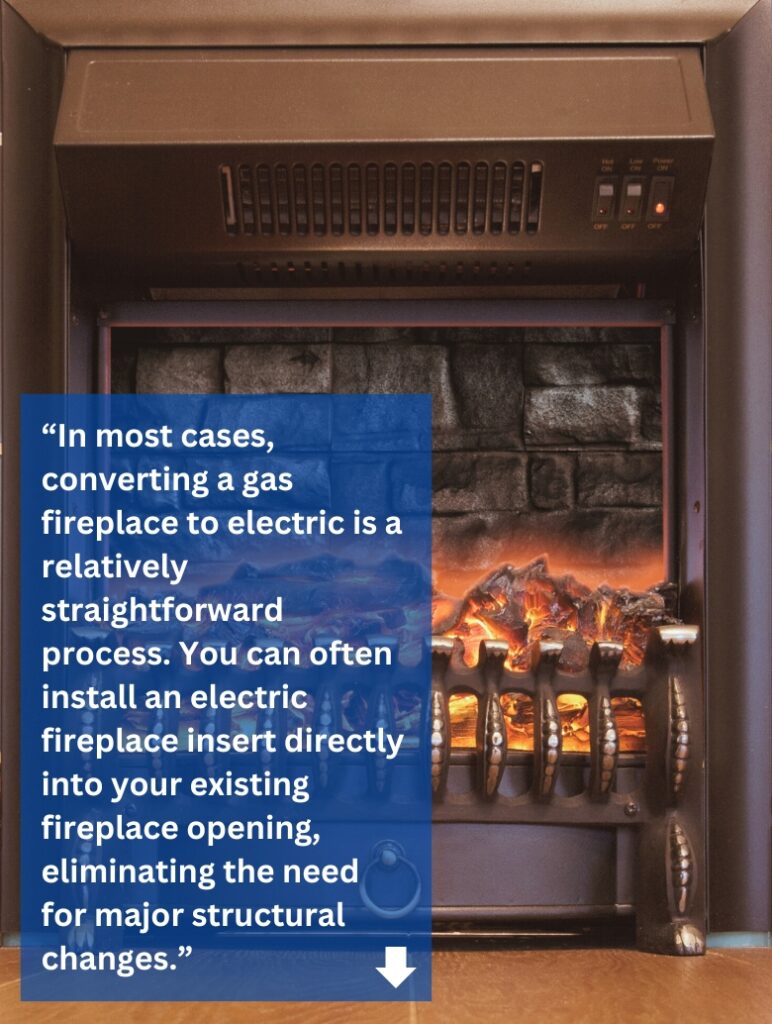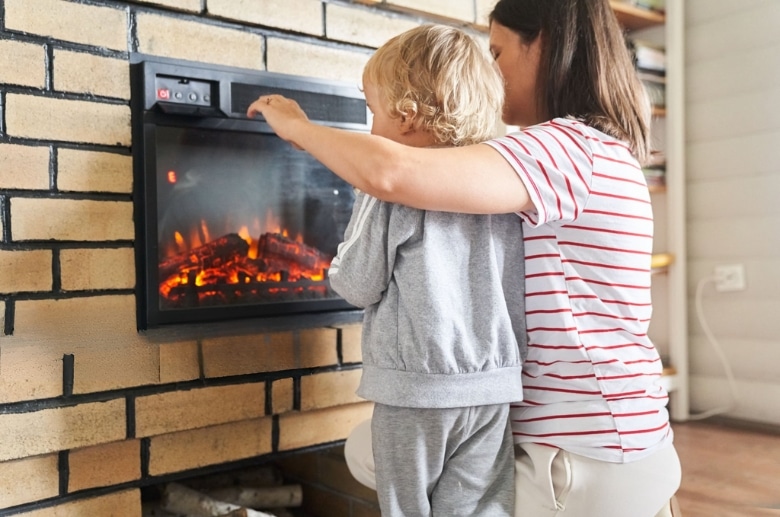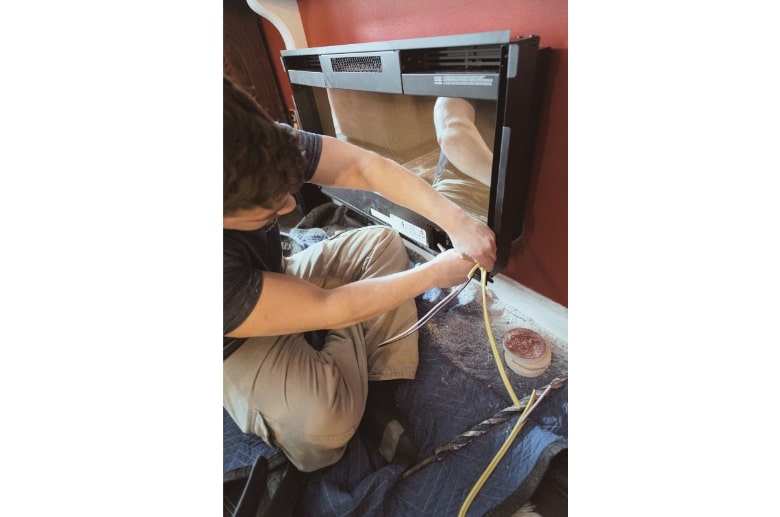Across the nation, a growing number of homeowners are transitioning from traditional gas fireplaces to their more efficient, electric alternatives.
This guide will detail these benefits and provide a simple, four-step process on how to convert a gas fireplace to electric, allowing you to enjoy a fireplace’s warmth and ambiance without the hassle of gas.
let’s get started!
Can I Convert a Gas Fireplace to Electric?
Absolutely! Converting a gas fireplace to electric is a viable and popular option for many homeowners.

In most cases, converting a gas fireplace to electric is a relatively straightforward process. You can often install an electric fireplace insert directly into your existing fireplace opening, eliminating the need for major structural changes.
Additionally, electric inserts come in a wide range of sizes, styles, and features, allowing you to customize the look and functionality of your fireplace to match your taste and budget. You can choose from traditional log sets to modern, flameless designs and even control the flame intensity and heat output from the comfort of your couch.
Overall, converting a gas fireplace to electric is a great option for many homeowners looking for a safer, more efficient, and environmentally friendly way to enjoy the warmth and ambiance of a fireplace.
——
Do You Need to Hire Chimney & Fireplace Expert?
Get free quotes from qualified experts near you. No commitment required!
——
Advantages of Converting a Gas Fireplace to Electric
Gas fireplace conversion is more than just a trendy upgrade – it’s a smart investment in your home’s comfort, safety, and environmental impact. As promised, here’s a closer look at the key advantages you can reap:
1. Cost-Effectiveness
Electric fireplaces convert nearly all their energy into heat, boasting up to 99% efficiency, compared to the 50-60% efficiency of gas models. The annual savings from using an electric fireplace compared to a gas fireplace is approximately $2.73. This is based on the following assumptions:
- The average heating season is 6 months
- An average household uses 50,000 BTU of heating per month
- Natural gas costs $1.2 per therm
- Electricity costs $0.1 per kWh
- Electric fireplace efficiency is 99%
- Gas fireplace efficiency is 55% (average of 50% and 60%)
Of course, these are just estimates, and your actual savings may vary depending on your specific circumstances. However, it is clear that electric fireplaces can be a more efficient and cost-effective way to heat your home.
That’s not all. Gas fireplaces require regular maintenance, including chimney cleaning and inspection, which can cost between $400 to $1,000 or more annually. Electric fireplaces, on the other hand, require minimal maintenance, further reducing your long-term costs.
2. Safety

Electric fireplaces eliminate the risk of open flames and potential gas leaks, making them a safer choice for families with children and pets. The National Fire Protection Association emphasizes the importance of fireplace safety, including using proper ventilation and extinguishing fires before leaving the room.
Moreover, gas fireplaces can emit carbon monoxide, a colorless, odorless gas that can be deadly. Electric fireplaces pose no such risk, ensuring a healthier and safer environment for your home.
3. Convenience

Most electric fireplace inserts can be easily installed into your existing fireplace opening, eliminating the need for major renovations. They also offer convenient features like remote control operation and programmable timers, making them incredibly user-friendly.
Unlike gas fireplaces, which require regular cleaning, electric fireplaces require minimal maintenance and leave no mess. This makes them a hassle-free choice for busy homeowners.
4. Energy-Efficiency
Electric fireplaces boast near-perfect efficiency, converting almost all their energy into heat. Traditional gas fireplaces, on the other hand, lose a significant amount of heat up the chimney due to their combustion process. Electric fireplaces can be up to 99% efficient, while gas models typically manage only 50-60%. This translates to:
- Less wasted energy: You’re paying for heat that stays in your living space, not escaping through the flue.
- Reduced heating needs: You can potentially lower your overall thermostat setting by focusing the heat on occupied areas.
5. Environment-Friendly
By utilizing electricity, which can increasingly come from renewable sources like solar or wind, electric fireplaces significantly reduce your carbon footprint compared to gas models. This aligns perfectly with the Environmental Protection Agency’s (EPA) focus on clean energy solutions and climate change mitigation.
Electric fireplaces don’t produce harmful emissions like carbon monoxide or particulate matter, contributing to cleaner indoor air and improved health for your family. The American Lung Association promotes healthy indoor air quality as a key factor in preventing respiratory issues and promoting overall well-being.
Factors to Consider Before Converting to Electric
Now that you know the advantages of converting your gas fireplace to electric, it’s time to look at what you should consider before jumping headfirst into this cozy upgrade.
Size and Style of Your Existing Gas Fireplace
The dimensions of your existing fireplace opening will dictate the size and style of electric insert you can accommodate. Carefully measure the width, height, and depth of the opening, accounting for any decorative features or mantelpieces.
Remember, electric inserts tend to be shallower than gas inserts, so ensure adequate depth is available.
Once you understand the size constraints, explore the diverse fireplace insert options. From traditional log sets with flickering flames to sleek, modern designs with glass panels and contemporary flame effects, there’s a style to complement your decor.
Electric Fireplace Insert Options and Features
Electric fireplace inserts come in a range of heating capacities, typically ranging from 4,000 to 9,000 BTUs (British thermal units). Choose an insert with a BTU output suited to the size of your room.
Note that electric fireplaces are generally less powerful than gas models, so they may not be suitable for heating large spaces as the primary source of heat. Consider supplementing with other heating systems or focusing on supplemental warmth and ambiance.
Additionally, modern electric fireplaces offer a plethora of features beyond basic heat. Remote control operation, adjustable flame intensity and colors, ambient lighting options, and even built-in timers are just a few bells and whistles to consider. Decide which features add value to your experience and fit your budget.
——
Do You Need to Hire Chimney & Fireplace Expert?
Get free quotes from qualified experts near you. No commitment required!
——
Initial Costs and Ongoing Budget Considerations
You can expect to pay anywhere from $500 to $2,000 or more for a basic electric fireplace insert. However, the cost of the insert itself can vary depending on the size, features, and brand.
Electric fireplaces are much cheaper to operate than gas fireplaces. The average cost to run an electric fireplace for an hour is about $0.13, while a gas fireplace can cost up to $1.00 per hour. In addition, electric fireplaces require little to no maintenance, while gas fireplaces need to be serviced annually.
Overall, converting a gas fireplace to electric can be a cost-effective way to enjoy the benefits of a fireplace without the high cost of gas. However, it is important to weigh the pros and cons carefully before making a decision.
Electrical Availability and Potential Upgrades
Electric fireplace inserts require a dedicated electrical circuit and sufficient amperage to operate safely. Assess the existing electrical capacity in your fireplace location and consult a qualified electrician if necessary. Upgrades to wiring or panel capacity might be required.
Also, consider the location of your existing electrical outlets and plan for any necessary extensions or rewiring to ensure the convenient placement of the insert and any remote control features.
Personal Preferences and Needs
Beyond the practical considerations, remember to evaluate your individual preferences and needs.
- Do you prioritize ambiance and aesthetics over primary heating?
- Do you crave the realistic look of a traditional log set, or are you drawn to the sleekness of modern designs?
- Do you desire smart home integration or prefer a simpler, manual operation?
Understanding your priorities will help you choose the perfect electric fireplace for your cozy vision.
Converting your gas fireplace to electric can be a delightful journey towards warmth, convenience, and environmental responsibility. By carefully considering these factors, you can stoke the flames of information and confidently choose the electric fireplace that perfectly complements your home and lifestyle.
How to Convert a Gas Fireplace to Electric
Before embarking on your cozy transformation, safety must be paramount. Gas fireplaces involve sensitive elements, so professional assistance is crucial at certain stages. Here’s what to prioritize:

Safety Requirements
- Professional Gas Line Shut-Off and Capping: Never attempt to handle the gas line yourself. Hire a licensed gas technician to disconnect and cap the gas line leading to your fireplace.
- Electrical Assessment and Potential Upgrades: Consult a qualified electrician to evaluate your existing electrical wiring and ensure it can handle the power requirements of your chosen electric fireplace insert. Upgrades may be necessary.
- Clearance and Ventilation: Verify the clearance requirements for your electric fireplace insert, particularly concerning surrounding materials and mantelpieces. Ensure any existing flue or venting is properly blocked and sealed according to local regulations.
- Permitting and Inspections (if applicable): Check with your local building department to see if permits are required for the conversion process. Some municipalities may also mandate inspections following the completed installation.
Now, with safety firmly in place, let’s turn up the warmth with these four conversion steps:
——
Do You Need to Hire Chimney & Fireplace Expert?
Get free quotes from qualified experts near you. No commitment required!
——
Step 1: Prepare the Fireplace Opening
Remove any existing gas logs, grates, and embers from the fireplace cavity. Clean the interior thoroughly, removing any soot or debris.
Check the dimensions of your fireplace opening against the chosen electric insert to ensure compatibility. Minor adjustments might be necessary.
Step 2: Install the Electric Fireplace Insert
Carefully position the electric insert within the fireplace opening, following the manufacturer’s instructions. Secure it in place with the provided mounting hardware.
Connect the insert’s electrical cord to the dedicated circuit, ensuring everything is grounded properly. If the insert is slightly smaller than the opening, a fireplace trim kit can be an effective solution.
These kits typically consist of metal or wood frames that can be customized to fill the gaps and create a visually seamless transition between the insert and the fireplace surround. They are often available in various styles and finishes to match your décor.
Step 3: Test and Optimize Functionality
Plug in the insert and turn it on. Verify that the heating element and any additional features (flames, lighting, etc.) operate correctly.
Adjust the heat output and other settings to your preference. Test the remote control functionality if applicable.
Step 4: Finishing Touches (optional)
For a seamless look, consider adding decorative trim or a surround around the insert to match your existing fireplace aesthetics.
Decorate the mantelpiece with candles, vases, or other ornaments to enhance the ambiance.
Bonus Tip: Consult manufacturer manuals and online resources for specific installation instructions and troubleshooting tips for your chosen electric fireplace model.
Remember, this is a general guide, and specific details may vary depending on your fireplace and chosen electric insert. Always prioritize safety, consult professionals where necessary, and enjoy the warmth and convenience of your newly transformed fireplace!
Final Thoughts
Converting your gas fireplace to electric unlocks a treasure chest of benefits: cleaner air, lower cost, enhanced safety, modern aesthetics, and environmental responsibility. But like any good story, there’s another side to the coin.
While most gas fireplaces seamlessly embrace the electric conversion, some might require adaptations or lack the space for certain insert styles. Consider your fireplace’s dimensions, your budget, and your desired heat output to gauge the feasibility.
Ultimately, the decision hinges on your priorities. Do you crave a warm glow sans the gas hassles? Do sustainability and efficient warmth resonate with you? Then, embrace the electric transformation!
Your home will thank you with cleaner air, lower bills, and a worry-free, eco-friendly fireplace experience.






